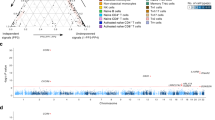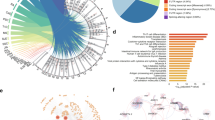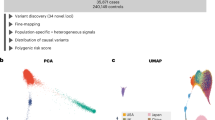Abstract
Rheumatoid arthritis is a common autoimmune disease with a complex genetic etiology. Here, through a genome-wide association study of rheumatoid arthritis, we identified a polymorphism in CCR6, the gene encoding chemokine (C-C motif) receptor 6 (a surface marker for Th17 cells) at 6q27, that was associated with rheumatoid arthritis susceptibility and was validated in two independent replication cohorts from Japan (rs3093024, a total of 7,069 individuals with rheumatoid arthritis (cases) and 20,727 controls, overall odds ratio = 1.19, P = 7.7 × 10−19). We identified a triallelic dinucleotide polymorphism of CCR6 (CCR6DNP) in strong linkage disequilibrium with rs3093024 that showed effects on gene transcription. The CCR6DNP genotype was correlated with the expression level of CCR6 and was associated with the presence of interleukin-17 (IL-17) in the sera of subjects with rheumatoid arthritis. Moreover, CCR6DNP was associated with susceptibility to Graves' and Crohn's diseases. These results suggest that CCR6 is critically involved in IL-17–driven autoimmunity in human diseases.
This is a preview of subscription content, access via your institution
Access options
Subscribe to this journal
Receive 12 print issues and online access
$209.00 per year
only $17.42 per issue
Buy this article
- Purchase on Springer Link
- Instant access to full article PDF
Prices may be subject to local taxes which are calculated during checkout


Similar content being viewed by others
References
Firestein, G.S. Evolving concepts of rheumatoid arthritis. Nature 423, 356–361 (2003).
Newton, J.L., Harney, S.M., Wordsworth, B.P. & Brown, M.A. A review of the MHC genetics of rheumatoid arthritis. Genes Immun. 5, 151–157 (2004).
Qin, S. et al. The chemokine receptors CXCR3 and CCR5 mark subsets of T cells associated with certain inflammatory reactions. J. Clin. Invest. 101, 746–754 (1998).
Yamada, H. et al. Th1 but not Th17 cells predominate in the joints of patients with rheumatoid arthritis. Ann. Rheum. Dis. 67, 1299–1304 (2008).
Harrington, L.E. et al. Interleukin 17-producing CD4+ effector T cells develop via a lineage distinct from the T helper type 1 and 2 lineages. Nat. Immunol. 6, 1123–1132 (2005).
Murphy, C.A. et al. Divergent pro- and antiinflammatory roles for IL-23 and IL-12 in joint autoimmune inflammation. J. Exp. Med. 198, 1951–1957 (2003).
Pernis, A.B. Th17 cells in rheumatoid arthritis and systemic lupus erythematosus. J. Intern. Med. 265, 644–652 (2009).
Hirota, K. et al. Preferential recruitment of CCR6-expressing Th17 cells to inflamed joints via CCL20 in rheumatoid arthritis and its animal model. J. Exp. Med. 204, 2803–2812 (2007).
Plenge, R.M. et al. TRAF1–C5 as a risk locus for rheumatoid arthritis—a genomewide study. N. Engl. J. Med. 357, 1199–1209 (2007).
Plenge, R.M. et al. Two independent alleles at 6q23 associated with risk of rheumatoid arthritis. Nat. Genet. 39, 1477–1482 (2007).
Wellcome Trust Case Control Consortium. Genome-wide association study of 14,000 cases of seven common diseases and 3,000 shared controls. Nature 447, 661–678 (2007).
Gregersen, P.K. et al. REL, encoding a member of the NF-κB family of transcription factors, is a newly defined risk locus for rheumatoid arthritis. Nat. Genet. 41, 820–823 (2009).
Price, A.L. et al. Principal components analysis corrects for stratification in genome-wide association studies. Nat. Genet. 38, 904–909 (2006).
Yamaguchi-Kabata, Y. et al. Japanese population structure, based on SNP genotypes from 7,003 individuals compared to other ethnic groups: effects on population-based association studies. Am. J. Hum. Genet. 83, 445–456 (2008).
Devlin, B., Roeder, K. & Wasserman, L. Genomic control, a new approach to genetic-based association studies. Theor. Popul. Biol. 60, 155–166 (2001).
Remmers, E.F. et al. STAT4 and the risk of rheumatoid arthritis and systemic lupus erythematosus. N. Engl. J. Med. 357, 977–986 (2007).
Kobayashi, S. et al. Association of STAT4 with susceptibility to rheumatoid arthritis and systemic lupus erythematosus in the Japanese population. Arthritis Rheum. 58, 1940–1946 (2008).
Lee, H.S. et al. Association of STAT4 with rheumatoid arthritis in the Korean population. Mol. Med. 13, 455–460 (2007).
Suzuki, A. et al. Functional haplotypes of PADI4, encoding citrullinating enzyme peptidylarginine deiminase 4, are associated with rheumatoid arthritis. Nat. Genet. 34, 395–402 (2003).
Stahl, E.A. et al. Genome-wide association study meta-analysis identifies seven new rheumatoid arthritis risk loci. Nat. Genet. advance online publication, doi:10.1038/ng.582 (9 May 2010).
Annunziato, F. et al. Phenotypic and functional features of human Th17 cells. J. Exp. Med. 204, 1849–1861 (2007).
Haas, J.D. et al. CCR6 and NK1.1 distinguish between IL-17A and IFN-gamma-producing γδ effector T cells. Eur. J. Immunol. 39, 3488–3497 (2009).
Schutyser, E., Struyf, S. & Van Damme, J. The CC chemokine CCL20 and its receptor CCR6. Cytokine Growth Factor Rev. 14, 409–426 (2003).
Frazer, K.A. et al. A second generation human haplotype map of over 3.1 million SNPs. Nature 449, 851–861 (2007).
Matsui, T. et al. Selective recruitment of CCR6-expressing cells by increased production of MIP-3 α in rheumatoid arthritis. Clin. Exp. Immunol. 125, 155–161 (2001).
Barrett, J.C. et al. Genome-wide association defines more than 30 distinct susceptibility loci for Crohn′s disease. Nat. Genet. 40, 955–962 (2008).
Brand, S. Crohn's disease: Th1, Th17 or both? The change of a paradigm: new immunological and genetic insights implicate Th17 cells in the pathogenesis of Crohn's disease. Gut 58, 1152–1167 (2009).
Wang, K. et al. Diverse genome-wide association studies associate the IL12/IL23 pathway with Crohn Disease. Am. J. Hum. Genet. 84, 399–405 (2009).
Nakamura, Y. The BioBank Japan Project. Clin. Adv. Hematol. Oncol. 5, 696–697 (2007).
Purcell, S. et al. PLINK: a tool set for whole-genome association and population-based linkage analyses. Am. J. Hum. Genet. 81, 559–575 (2007).
Wigginton, J.E., Cutler, D.J. & Abecasis, G.R. A note on exact tests of Hardy-Weinberg equilibrium. Am. J. Hum. Genet. 76, 887–893 (2005).
Kochi, Y. et al. A functional variant in FCRL3, encoding Fc receptor-like 3, is associated with rheumatoid arthritis and several autoimmunities. Nat. Genet. 37, 478–485 (2005).
Tokuhiro, S. et al. An intronic SNP in a RUNX1 binding site of SLC22A4, encoding an organic cation transporter, is associated with rheumatoid arthritis. Nat. Genet. 35, 341–348 (2003).
Suzuki, A. et al. Functional SNPs in CD244 increase the risk of rheumatoid arthritis in a Japanese population. Nat. Genet. 40, 1224–1229 (2008).
Raychaudhuri, S. et al. Common variants at CD40 and other loci confer risk of rheumatoid arthritis. Nat. Genet. 40, 1216–1223 (2008).
Thomson, W. et al. Rheumatoid arthritis association at 6q23. Nat. Genet. 39, 1431–1433 (2007).
Shimane, K. et al. The association of a nonsynonymous single-nucleotide polymorphism in TNFAIP3 with systemic lupus erythematosus and rheumatoid arthritis in the Japanese population. Arthritis Rheum. 62, 574–579 (2010).
Raychaudhuri, S. et al. Genetic variants at CD28, PRDM1 and CD2/CD58 are associated with rheumatoid arthritis risk. Nat. Genet. 41, 1313–1318 (2009).
Okada, Y. et al. SLC22A4 polymorphism and rheumatoid arthritis susceptibility: a replication study in a Japanese population and a meta-analysis. J. Rheumatol. 35, 1723–1728 (2008).
Nishimoto, K. et al. Association study of TRAF1–C5 polymorphisms with susceptibility to rheumatoid arthritis and systemic lupus erythematosus in Japanese. Ann. Rheum. Dis. 69, 368–373 (2010).
Aikawa, Y., Yamamoto, M., Yamamoto, T., Morimoto, K. & Tanaka, K. An anti-rheumatic agent T-614 inhibits NF-κB activation in LPS- and TNF-α-stimulated THP-1 cells without interfering with IκBα degradation. Inflamm. Res. 51, 188–194 (2002).
Shimane, K. et al. A single nucleotide polymorphism in the IRF5 promoter region is associated with susceptibility to rheumatoid arthritis in the Japanese population. Ann. Rheum. Dis. 68, 377–383 (2009).
Acknowledgements
We thank K. Shimada, Y. Hayashi, K. Kobayashi, M. Kitazato and other members of the Laboratory for Autoimmune Diseases, RIKEN and Y. Katagiri at Tokyo Women's Medical University, for their technical assistance. We also thank the members of BioBank Japan and the Rotary Club of Osaka-Midosuji District 2660 Rotary International for supporting our study. This work was conducted as a part of the BioBank Japan Project that was supported by the Ministry of Education, Culture, Sports, Sciences and Technology of the Japanese government. The replication study of rheumatoid arthritis was performed under the support of Genetics and Allied research in Rheumatoid Arthritis Networking (GARNET) consortium.
Author information
Authors and Affiliations
Contributions
Y.K., Y.O. and K. Yamamoto. designed the study and drafted the manuscript. Y.O., A.T., T.T. and R.Y. analyzed the GWAS data. N.H. and M.K. performed the genotyping for the GWAS. Y.K. performed expression analysis of CCR6 and functional analysis of CCR6 polymorphisms. Y.K. and K.M. established the genotyping method for CCR6DNP. K.I., S.M. and H.Y. analyzed data for the first replication cohort of rheumatoid arthritis. C.T., K.O., T.M., R.Y. and F.M. analyzed the data for the second replication cohort of rheumatoid arthritis. Y.K. analyzed the data for the Graves' disease cohort. K. Yamazaki analyzed the data for the Crohn's disease cohort. T.F. and S.I. analyzed the data for the fourth control cohort. T.I. and K.I. analyzed CCR6 expression in the synovial tissues. Y.K. and A.S. analyzed the sera of subjects with rheumatoid arthritis. M.K., N.K. and Y.N. contributed to overall GWAS study design.
Corresponding author
Ethics declarations
Competing interests
The authors declare no competing financial interests.
Supplementary information
Supplementary Text and Figures
Supplementary Note, Supplementary Tables 1–6 and Supplementary Figures 1–6 (PDF 803 kb)
Rights and permissions
About this article
Cite this article
Kochi, Y., Okada, Y., Suzuki, A. et al. A regulatory variant in CCR6 is associated with rheumatoid arthritis susceptibility. Nat Genet 42, 515–519 (2010). https://doi.org/10.1038/ng.583
Received:
Accepted:
Published:
Issue Date:
DOI: https://doi.org/10.1038/ng.583
This article is cited by
-
Gene selection by incorporating genetic networks into case-control association studies
European Journal of Human Genetics (2024)
-
The Relationship Between Chemokine and Chemokine Receptor Genes Polymorphisms and Chronic Obstructive Pulmonary Disease Susceptibility in Tatar Population from Russia: A Case Control Study
Biochemical Genetics (2022)
-
Germinal Center-Related G Protein-Coupled Receptors in Antibody-Mediated Autoimmune Skin Diseases: from Basic Research to Clinical Trials
Clinical Reviews in Allergy & Immunology (2022)
-
Preclinical and clinical characterization of the RORγt inhibitor JNJ-61803534
Scientific Reports (2021)
-
CCR6+ group 3 innate lymphoid cells accumulate in inflamed joints in rheumatoid arthritis and produce Th17 cytokines
Arthritis Research & Therapy (2019)



